UTech, Jamaica Architecture Students Collaborate with Touraterre for “Raw Earth” Mud Prototype Construction Project

The University of Technology, Jamaica through its Caribbean School of Architecture, Faculty of The Built Environment collaborated with Touraterre, a French organization of architects promoting raw earth architecture and construction techniques, to design and build a “raw earth” or adobe mud prototype in the hills of Irish Town, St Andrew. Dubbed the “a IT dat Mud House Project”, the house was constructed in 2016 in the tradition of the wattle and daub method of building, with mud from the Blue Mountains, and coconut tree fibres sourced from the Coconut Industry Board of Jamaica. The project commenced with a design workshop with eight architectural students in 2016, and construction was completed in December 2019, with additional input from the International Centre on Earthen Architecture (CRAterre), and the National Environmental & Planning Agency (NEPA). The design of the house, initially a small guest house, was reimagined as a farm house, and was chosen from a competition open to students from the Caribbean School of Architecture and students of Architecture from France. The building was erected by CSA students and community members of Irish Town. It consists of a mud-fiber mixture wrapped around a wooden frame, with a lime finish applied to protect the outer layer.
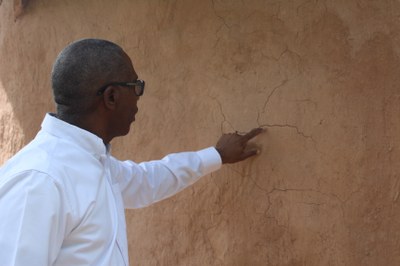
Dr. Garfield Young, Dean, Faculty of The Built Environment indicates a tiny crack in the outer wall of the Mud House, explaining that these gaps are easily repaired and are of no threat to the structural soundness of the building during a visit and tour of the site on January 15, 2020.
Dr. Garfield Young, Dean of the Faculty of The Built Environment, explained that the project represents a step in the University’s efforts to lead the research that establishes innovative construction techniques that are sustainable and suitable for a tropical setting, and that respond well to hurricanes, earthquakes and the mounting effects of climate change. “It is a very interesting research that has implications for how we build going forward, and how our buildings will respond to the kinds of things we have to face as a people,” he said. Dr. Young also indicated that using adobe construction techniques reduces the cost of materials, and negates the need for insulation or for cooling mechanisms, such as central air conditioning. Mud buildings can also be as strong as concrete if properly built.
Mr Adrien Jacques le Seigneur, lead architect, Touraterre, pointed out that the technique of wattle and daub construction used to build the prototype was a mixture of British, Taino and Jamaican traditions, that was reinterpreted to fit modern methods of construction. He however, pointed out that the construction was not without its challenges. “It was a big challenge on this site because we had no water, no electricity and no road access. To make it doable, we prefabricated the whole building in Irish Town, because there was a place where we could plug our tools to cut all the wood, and prepare everything,” he said. “We brought the prefabricated elements on the site and then assembled them.”
Addressing the perceived “rough” aesthetics of the building, Mr. Le Seigneur admitted that “it’s true the way we work with the mud on this building was not the best because we had a lot of constraints, but with mud we can do every kind of affect we want.” Dr Young added that the project would be used as an example of the versatility of adobe construction, and the buildings performance in adverse weather would be recorded and made available through the University.
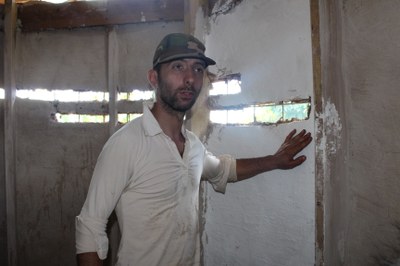
Mr. Le Seigneur points to a painted section of the house, explaining that mud is a versatile material and can be fashioned to mimic the look of more modern finishes, including “pebble-dash”, plastic or concrete.
Construction in Progress
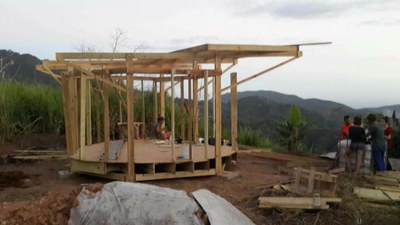
The wooden frame of the house, around which mud was wrapped.
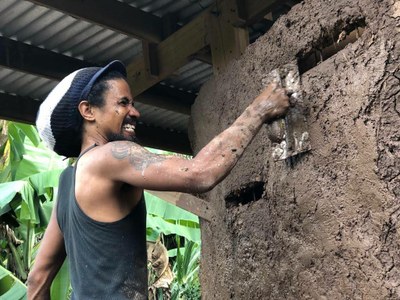
Ricardo Lucien, final year Caribbean School of Architecture student, works on the construction of the adobe “a IT dat Mud House Project”. Lucien said that he was pleased to have been a part of the project and happy with the opportunity to see the practical application of theories of architecture.
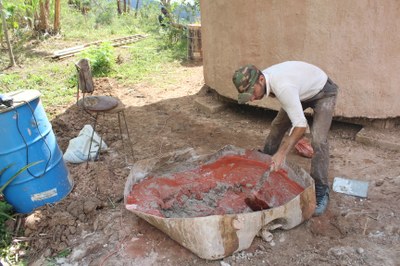
Adrien Jacques Le Seigneur mixes red ochre, mud and lime to apply a final coat to the “a IT dat Mud House Project” in Irish Town, St Andrew.
End.
Contact:
Michelle Beckford (Mrs.)
Corporate Communications Manager
University of Technology, Jamaica
Telephone: 970-5299
Email: mbeckford@utech.edu.jm
